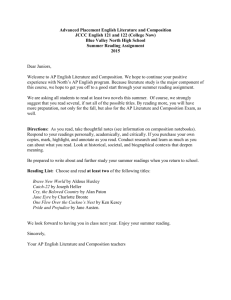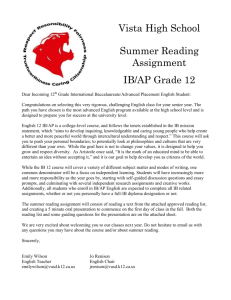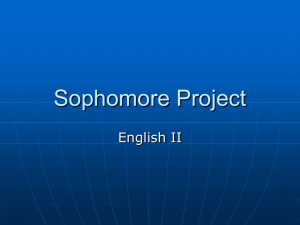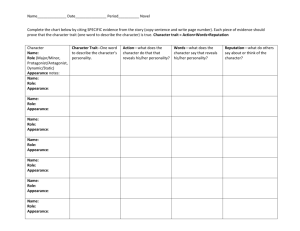Sample Character Traits
advertisement
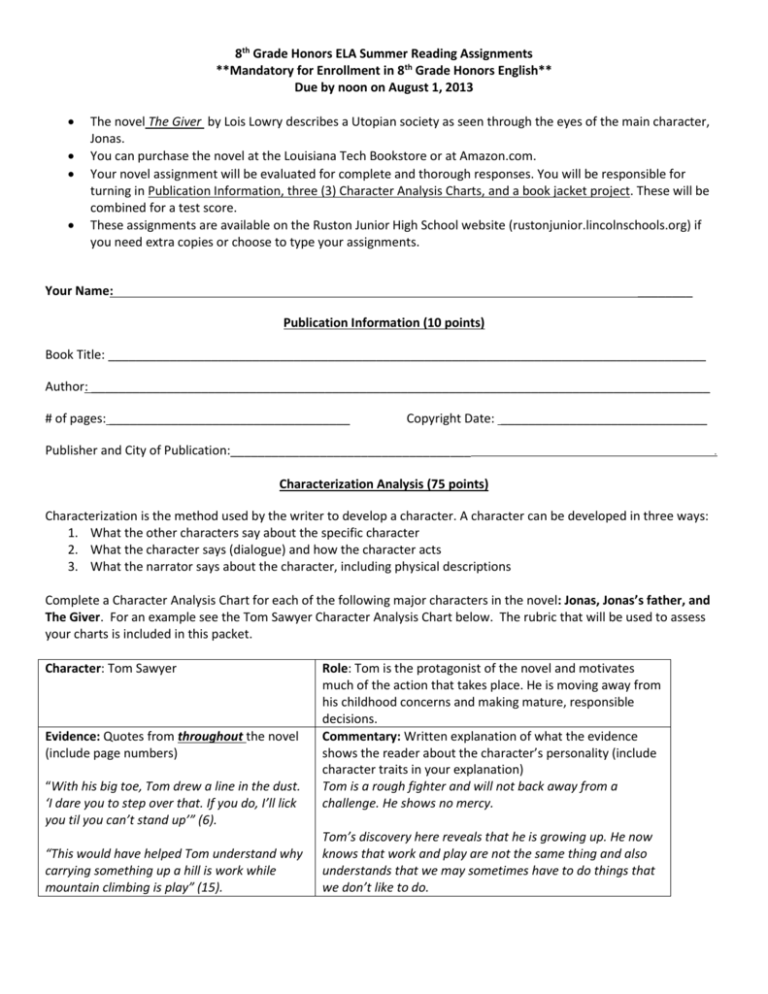
8th Grade Honors ELA Summer Reading Assignments **Mandatory for Enrollment in 8th Grade Honors English** Due by noon on August 1, 2013 The novel The Giver by Lois Lowry describes a Utopian society as seen through the eyes of the main character, Jonas. You can purchase the novel at the Louisiana Tech Bookstore or at Amazon.com. Your novel assignment will be evaluated for complete and thorough responses. You will be responsible for turning in Publication Information, three (3) Character Analysis Charts, and a book jacket project. These will be combined for a test score. These assignments are available on the Ruston Junior High School website (rustonjunior.lincolnschools.org) if you need extra copies or choose to type your assignments. Your Name: ________ Publication Information (10 points) Book Title: _______________________________________________________________________________________ Author: __________________________________________________________________________________________ # of pages: ___________________________________ Copyright Date: ______________________________ Publisher and City of Publication:___________________________________ Characterization Analysis (75 points) Characterization is the method used by the writer to develop a character. A character can be developed in three ways: 1. What the other characters say about the specific character 2. What the character says (dialogue) and how the character acts 3. What the narrator says about the character, including physical descriptions Complete a Character Analysis Chart for each of the following major characters in the novel: Jonas, Jonas’s father, and The Giver. For an example see the Tom Sawyer Character Analysis Chart below. The rubric that will be used to assess your charts is included in this packet. Character: Tom Sawyer Evidence: Quotes from throughout the novel (include page numbers) “With his big toe, Tom drew a line in the dust. ‘I dare you to step over that. If you do, I’ll lick you til you can’t stand up’” (6). “This would have helped Tom understand why carrying something up a hill is work while mountain climbing is play” (15). Role: Tom is the protagonist of the novel and motivates much of the action that takes place. He is moving away from his childhood concerns and making mature, responsible decisions. Commentary: Written explanation of what the evidence shows the reader about the character’s personality (include character traits in your explanation) Tom is a rough fighter and will not back away from a challenge. He shows no mercy. Tom’s discovery here reveals that he is growing up. He now knows that work and play are not the same thing and also understands that we may sometimes have to do things that we don’t like to do. . Book Jacket Project (15 points) Supplies: White, unlined copy paper, 8 ½ x 11 or 8 ½ X 14 Colored pencils, markers, etc. Directions: Fold the paper so that it covers the book around both sides just as it were a true book jacket. Inside the jacket on the left fold, write an original plot (events in the novel) summary about the novel. Do not copy from the back of the book. The summary should start with the beginning of the novel and go through to the end, but do not give the ending away. (5 points) Inside the jacket on the right fold, write some brief information on the author. This can be found on the internet. Author information should include awards won and reviews given about the author and his/her books. (5 points) The front of the book jacket should be a representation of the book and must not be copied from the book. Use your imagination to illustrate the title and plot, themes, or characters. Your cover must be neat and attractive. (5 points) The plot summary and author information should be written in your own words and not plagiarized. Character Analysis Rubric Character Needs Improvement Fair Good Excellent Role Excellent=8 points Good=6 points Fair=4 points Needs Improvement=2 The description of the role does not sufficiently explain the character’s importance in the novel as a whole. Language control* errors significantly detract from the author’s meaning. The description of the role adequately explains the character’s importance in the novel as a whole. Language control errors are present but do not significantly detract from the author’s meaning. The description of the role sufficiently explains the character’s importance in the novel as a whole. Language control errors are minimal. Evidence/Commentary Excellent=17 points Good=15 points Fair=11 points Needs Improvement=8 The evidence is carelessly chosen and inconsistently pulled from the text. Whole chapters have not been included. The commentary provides little more than a summary of the evidence. The selection of evidence is inconsistent and may not demonstrate careful reading. Significant moments of characterization have not been included. The commentary merely provides a summary of the evidence and does not indicate what traits are made evident. Page references are included for ALL quotes. The selection of evidence shows careful reading and consideration of the author’s characterization of the selected character. Each quote selected is explained in accompanying commentary and indicates what character traits are made evident. Page references are included for ALL quotes. The description of the role is insightful and thorough. The character’s importance in the novel as a whole is clearly explained. Language control is evident and in some places contributes to the effectiveness of the author’s meaning. The selection of evidence shows deep reading and thorough consideration of the author’s characterization of the selected character. Each quote selected is thoroughly explained in accompanying commentary and clearly indicates what character traits are made evident. Page references are included for ALL quotes. OR Page references are not included for ALL quotes. *Language control refers to the author’s effective and accurate use of grammar and mechanics. Character Analysis Chart Character: Role: Evidence: Quotes from throughout the novel (include page numbers) Commentary: Written explanation of what the evidence shows the reader about the character’s personality (include character traits in your explanation) Character Analysis Chart Character: Role: Evidence: Quotes from throughout the novel (include page numbers) Commentary: Written explanation of what the evidence shows the reader about the character’s personality (include character traits in your explanation) Character Analysis Chart Character: Role: Evidence: Quotes from throughout the novel (include page numbers) Commentary: Written explanation of what the evidence shows the reader about the character’s personality (include character traits in your explanation) Sample Character Traits able active adventurous affectionate afraid alert ambitious angry annoyed anxious apologetic arrogant attentive average bad blue bold bored bossy brainy brave bright brilliant busy calm careful careless cautious charming cheerful childish clever clumsy coarse concerned confident confused considerate cooperative courageous cowardly cross cruel curious dangerous daring dark decisive demanding dependable depressed determined discouraged dishonest disrespectful doubtful dull dutiful eager easygoing efficient embarrassed encouraging energetic evil excited expert fair faithful fearless fierce foolish fortunate foul fresh friendly frustrated funny gentle giving glamorous gloomy good graceful grateful greedy grouchy grumpy guilty happy harsh hateful healthy helpful honest hopeful hopeless humorous ignorant imaginative impatient impolite inconsiderate independent industrious innocent intelligent jealous kindly lazy leader lively lonely loving loyal lucky mature mean messy miserable mysterious naughty nervous nice noisy obedient obnoxious old peaceful picky pleasant polite poor popular positive precise proper proud quick quiet rational reliable religious responsible restless rich rough rowdy rude sad safe satisfied scared secretive selfish serious sharp short shy silly skillful sly smart sneaky sorry spoiled stingy strange strict stubborn sweet talented tall thankful thoughtful thoughtless tired tolerant touchy trusting trustworthy unfriendly unhappy upset useful warm weak wicked wise worried wrong young

